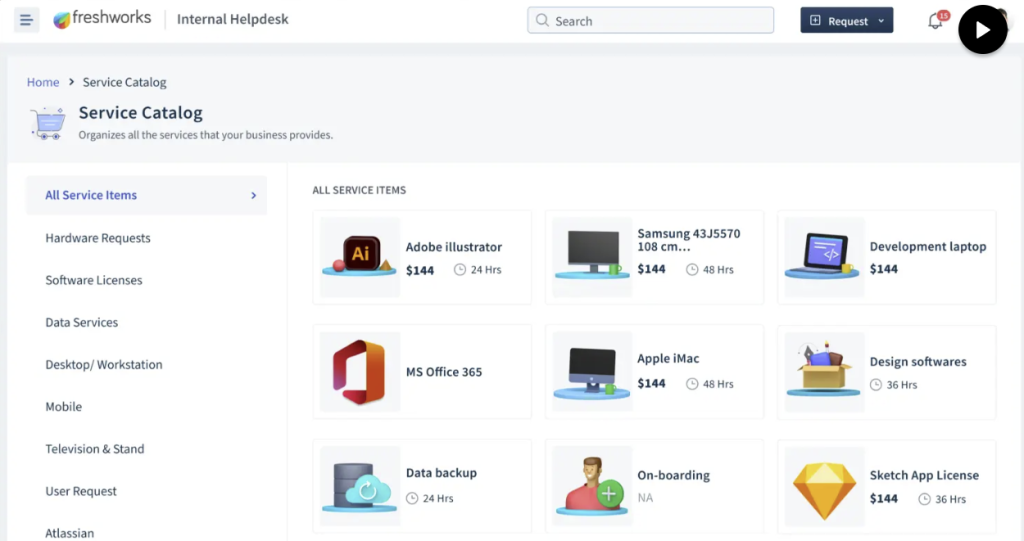Freshservice is a cloud-based IT service management (ITSM) solution that helps organizations manage their IT operations and provide support to their customers. Freshservice offers a range of features, such as incident management, problem management, change management, release management, asset management, service catalog, knowledge base, and reporting. In this review, I will outline the functionality of Freshservice and describe the pros and cons of using it.

Functionality of Freshservice:
- Incident management: Freshservice allows users to create, track, and resolve incidents through a web-based interface or email. Users can assign incidents to agents or groups, set priorities and SLAs, add notes and attachments, and communicate with customers via email or chat. Freshservice also supports automation rules and workflows to streamline the incident resolution process.
- Problem management: Freshservice enables users to identify and analyze the root causes of recurring incidents and prevent them from happening again. Users can link problems to incidents, changes, and assets, create problem records, assign tasks to agents or groups, and monitor the progress and status of problem resolution.
- Change management: Freshservice helps users to plan, approve, implement, and review changes to the IT infrastructure. Users can create change requests, define approval workflows, attach documents and files, schedule changes, and track the impact and outcome of changes. Freshservice also integrates with third-party tools such as Jira, GitHub, Bitbucket, and Jenkins to facilitate change management.
- Release management: Freshservice allows users to manage the deployment of software updates and new features to the IT environment. Users can create release plans, define release stages and tasks, assign roles and responsibilities, link releases to changes and incidents, and track the progress and status of releases. Freshservice also supports automation rules and workflows to ensure smooth and timely release delivery.
- Asset management: Freshservice enables users to discover, track, and manage the IT assets across the organization. Users can scan the network and import asset data from various sources such as Active Directory, SCCM, AWS, Azure, etc. Users can also create asset categories and types, assign assets to users or departments, monitor asset health and performance, and generate asset reports.
- Service catalog: Freshservice provides users with a self-service portal where they can request IT services and products from a predefined catalog. Users can browse the catalog by category or search by keywords, view the details and costs of each service or product, submit requests with custom fields and attachments, and track the status and approval of their requests. Freshservice also supports automation rules and workflows to simplify the service delivery process.
- Knowledge base: Freshservice helps users to create and maintain a repository of articles and FAQs that provide solutions to common IT issues and queries. Users can access the knowledge base from the self-service portal or the agent interface, search by keywords or categories, rate and comment on articles, and suggest improvements or new topics. Freshservice also supports automation rules and workflows to ensure the quality and relevance of the knowledge base content.
- Reporting: Freshservice offers users a comprehensive dashboard where they can view various metrics and insights on their IT operations and performance. Users can customize the dashboard with widgets that display data such as ticket volume, resolution time, SLA compliance, customer satisfaction,
change success rate etc. Users can also create custom reports using filters
and charts or use predefined templates for common reports such as incident
analysis report problem analysis report change analysis report etc.
Pros of Freshservice:
- Freshservice is easy to use both for agents and customers with its intuitive and user-friendly interface
- Freshservice is scalable and flexible with its cloud-based architecture and various plans that suit different business sizes and needs
- Freshservice is feature-rich and covers all the essential aspects of ITSM with its modules such as incident management problem management change management etc.
- Freshservice is customizable and configurable with its options to create custom fields forms workflows rules etc.
- Freshservice is integrable with many popular tools such as Jira Slack Teams Zoom etc that enhance its functionality
Cons of Freshservice:
- Freshservice can be expensive for some users especially for those who need advanced features such as project management or advanced analytics
- Freshservice can be slow at times due to its cloud-based nature which may affect its performance or availability
- Freshservice can be complex for some users who may find it difficult to set up or use some of its features such as automation rules or integrations
- Freshservice can be buggy at times due to its frequent updates or changes which may cause some issues or errors
Conclusion:
Freshservice is a powerful ITSM solution that offers a comprehensive set of features that help organizations manage their IT operations efficiently effectively and securely. It has many advantages such as ease of use scalability flexibility customization integration that make Freshservice an excellent choice for those looking for an affordable IT Management system.






Leave a Reply